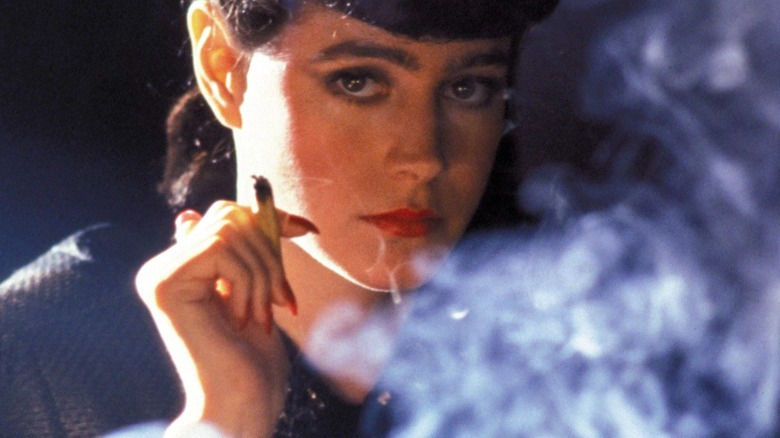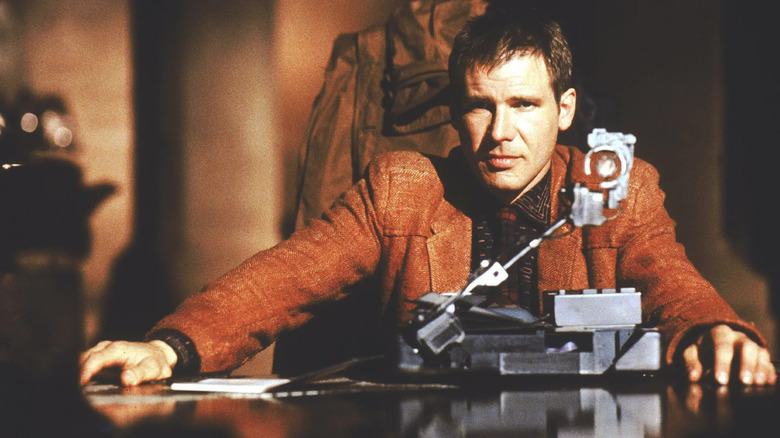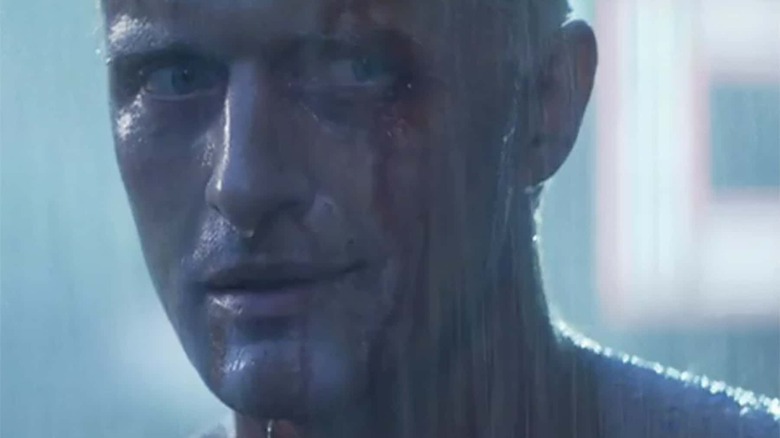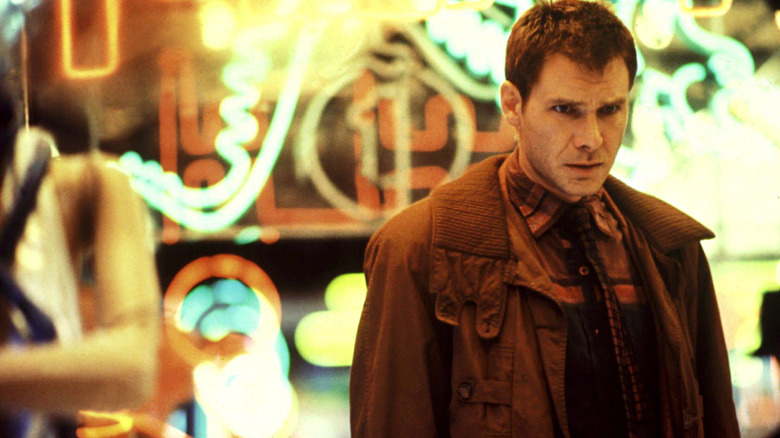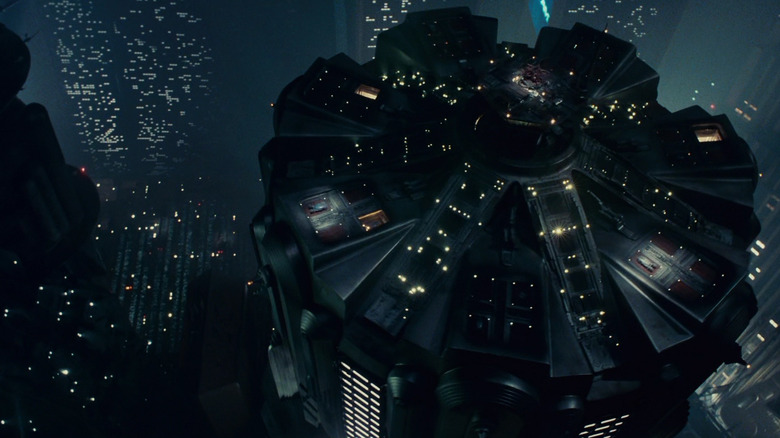The Blade Runner Curse Explained
Ridley Scott's 1982 cult film "Blade Runner" was released in June of 1982 to little critical fanfare — critics took issue with the film's sleepy, languid pacing, per the Deseret News — and low-to-middling financial success. At the time, "Blade Runner" only made only $6 million in its opening weekend on a budget of $30 million. Many have cited the initial mixed response to the fact that "Blade Runner" was released into a year that was already oversaturated with high-profile sci-fi releases including "E.T.: The Extra-Terrestrial," "Star Trek II: The Wrath of Khan," and the John Carpenter flop "The Thing." It was nominated for two Academy Awards, but lost both.
Over the years, "Blade Runner" has inspired a major critical reappraisal, with some eventually calling it one of the best science fiction films ever made — it was considered the 94th best film of the 20th century in The Village Voice's 2001 poll, appeared at #45 in the 2002 Sight and Sound poll, and had made its way up to #18 in a 2018 survey in Empire Magazine. Ridley Scott has also been variously inspired to recut his film several times, leading to fun fan debates as to which of the seven "official" versions is the best, or at least the purest. "Blade Runner: The Final Cut," release in 2005, may indeed be the final word on the matter.
There is a general consensus about "Blade Runner," today. Complaints of its dullness and horribly slow pace persist, but most viewers are taken by its themes of human identity in a corporate universe full of ads and consumption. With that in mind, many of the film's fans remain baffled as to how it could have been as poorly received as it was in 1982. Some have even gone to far as to note that the film is cursed, as many of the products advertised in the film — corporate billboards are a common feature in the world of "Blade Runner" — have since gone belly-up.
Whither Pan Am?
"Blade Runner" is set in Los Angeles in the far-off future of 2019. In that world, billboards garishly festoon most buildings, and companies have been involved in creating a synthetic workforce of artificial humans programmed with finite lifespans. Harrison Ford plays a detective whose specialty is performing Turing tests (using a fictional device called a Voight-Kampff machine) on synthetic humans to ensure that they are indeed humans: the copies have gotten so good, it's hard to tell the difference anymore.
The bleak, shadowy, well-photographed world of "Blade Runner" is a place where humans seem to vanish, and the corporate advertising is the thing swallowing them up. Similar themes would be revisited only a few years later in Terry Gilliam's "Brazil," wherein bureaucratic paperwork literally ate people alive: This is what happens when the world rounds 1984. These anti-corporate themes, however, seem to have leaked into the actual products advertised. To lend the film authenticity, Ridley Scott peppered his backgrounds and landscapes with actual product names, postulating they'd be recognizable to 1982 audiences.
Among them: Pan Am. Pan American Airwaves was founded in 1927, and by the late 1970s, was flying billions of miles annually (according to IATA World Air Transport Statistics 1981 – 1989). By 1982, however, Pan Am was already in financial dire straits, largely thanks to the rise in fuel prices. Pan Am went through a series of mergers and sell-off throughout the decade. It was the bombing of Pam Am flight 103 in 1988 that resulted in the loss of 270 lives — and the resultant $300 million lawsuit — that pushed the company to the brink. The beginning of Operation Desert Storm in 1990, which severely curtailed American air travel, sealed the deal on Pan Am, and it declared bankruptcy in 1991. This was after the shuttering of Eastern Air Lines and Midway Airlines that same year. The Golden Age of commercial air travel was essentially at an end.
Pan Am eventually served as the inspiration for a primetime soap opera by the same name. That show only lasted one season.
Atari
Also seen in the 2019 Los Angeles of "Blade Runner" was Atari, the video game giant that filed for bankruptcy in 2014.
Atari was founded in California in 1972 by Nolan Bushnell and Ted Dabney, whose 1978 game "Pong" unleashed commercial video games into the world. Throughout the early 1980s, Atari stood astride the video game market like a mighty colossus, invading homes and arcades alike. It turns out Atari would be undone by the same movie that likely undid "Blade Runner."
Steven Spielberg's "E.T.: The Extra-Terrestrial" was released on June 11, 1982, and was an immediate success, earning millions and eventually garnering Oscar nominations. On the 25th of that same month, both "Blade Runner" and John Carpenter's "The Thing" were released in its wake. It was the warmth and humanity of "E.T." that likely scared audiences away from Scott's turgid, bleak movie, and Carpenter's goopy horror movie.
In 1983, Atari was succumbing to infighting and various programmers claiming that they weren't getting credit for the games they created. Third-party games started flooding the market, and production times became shorter and shorter. The breakneck schedule at Atari led to the now-notorious five-week turnaround on the high-profile licensed game version of "E.T.," intended to be the hot Christmas item that year. Now often called the worst video game ever made, "E.T." sold so poorly that hundreds of copies were returned the to manufacturer, and the cartridges themselves were buried in a landfill in New Mexico. The home video game industry crashed for a time, and wouldn't be revived until a little company called Nintendo stepped in and entrenched itself in the popular consciousness for the next 40 years. A fascinating 2014 documentary film called "Atari: Game Over" traces the history of the company at this time, as well as an effort to dig up and retrieve the cartridges, now an open secret to the video game collecting public.
You can play the "E.T." video game on various online emulators.
Bell
Other companies featured in "Blade Runner" didn't dissolve or get bought out, but they did go through tough financial times.
Bell Systems, founded by none other than Alexander Graham Bell in 1877, pretty much ran all telecommunications in the United States for over a century. The American Telephone and Telegraph Company, better known as AT&T, purchased Bell Systems in 1899, leading to its dominance in the field. Other companies had been accusing Bell of running a monopoly since he 1910s, and the government tried to break it up in 1914. Thanks to a shady agreement called The Kingsbury Commitment, AT&T avoided breakup by selling off its portions of Western Union (!). This clever legal dodge led to AT&T's utter ubiquity and the company's value ballooned to about $150 billion in the early 1980s.
It was at this time that Bell/AT&T tried to branch into computer technology, leading to the government's antitrust division finally, effectively cracking down on them. After over a century of market dominance, AT&T was forcibly broken up in January of 1982, and other telecommunications were finally able to operate. Seeing the Bell logo in "Blade Runner," which opened in June, might have elicited an ironic chuckle from audience members that knew the company's fate.
AT&T lost 70% of its value in 1982, and its assets were out to pasture. Ironically, two of the new companies that were formed in the wake of Bell's breakup — Pacific Telesis, and Ameritech — were eventually bought back by AT&T. These days, the majority of American telecommunications are owned by three companies: AT&T, Verizon, and Lumen Technologies. It makes one want to switch to Mint Mobile.
Other companies as well
RCA, formed in 1919, has items are featured in "Blade Runner" as well, and that company was bought out by General Electric in 1986, and was dismantled. The music production arm of RCA remained, however, eventually coming to rest in the hands of the Sony Corporation. RCA records puts out music by Christina Aguilera, Foo Fighters, and Kelly Clarkson. A dark legacy of that company: Many of RCA's early industrial sites have been found to contain toxic waste (per SF Gate).
Cuisinart products can be seen in the kitchens of "Blade Runner." In 1988, Cuisinart filed for bankruptcy, and was eventually bought out by the Conair company. Since then, the brand has managed to make a comeback, and Cuisinart products are widely available to this day.
Coca-Cola is featured in "Blade Runner" as well, which is the company behind New Coke, now considered one of the biggest marketing blunders of all time. Thanks to the brilliance of "Coca-Cola Classic," however, the company bounced back and appears to be doing just fine.
